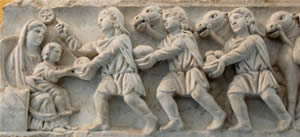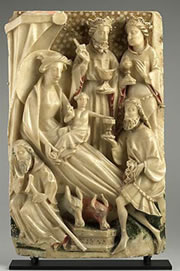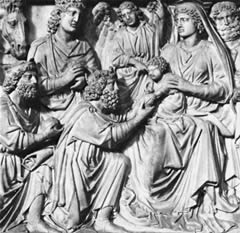An Urban Epiphany
A guest essay by Edwina Gateley. Gateley's journey has led her to teaching in Africa, founding Volunteer Missionary Movement, sojourning in the Sahara Desert, spending nine months of prayer in a trailer in the woods, befriending and ministering to street people and women in prostitution — "God's little ones," and preaching the Good News that God Is With Us. Edwina is a poet, theologian, artist, writer, lay minister, modern-day mystic and prophet, and a single mom. She gives talks, conferences and retreats in the United States, as well as internationally, while continuing to reach out to women in recovery from drugs and prostitution. You can visit her website here.
For Sunday January 5, 2014
The Feast of Epiphany
Lectionary Readings (Revised Common Lectionary, Year A)
Jeremiah 31:7–14 or Sirach 24:1–2
Psalm 147:12–20 or Wisdom of Solomon10:15–21
Ephesians 1:3–14
John 1:1–18
The Epiphany celebrates the journey of the Magi bringing gifts in recognition of the Incarnation — the coming of Christ into our world. “Epiphany” is derived from a Greek word meaning revelation or an intuitive grasp of a new reality. The three kings experienced this consciousness of mystery in the birth of Christ.
Such insights change one’s perception of reality forever. As did my encounter with an old street wino.
He was dirty and he smelled. I almost tripped over him lying on the sidewalk — drunk as a skunk and “out of it” as they say. My religious tradition had taught me to see Jesus in everyone. But this was a bit much. There was not a shred of revelation or glory or good news at my feet.
 |
Adoration of the Magi. Panel from a Roman sarcophagus, 4th century CE. From the cemetery of St. Agnes in Rome. |
I didn’t even think of trying to do anything for Mark, who was clearly past any hope of transformation. But, over the years, I got to know and befriend the old wino. Beneath all his external diminishment there eventually emerged a gentle soul — it was like finding a diamond in a dung heap. Whenever Mark knew that I was going to be out on the streets doing out-reach to the women in prostitution, he would go to the Salvation Army, shower, shave, change clothes, and not take a drink that day. He would then accompany me on my street walks like a respectable co-minister!
As time went by, Mark joined me in visiting friends who lived in a small Christian community in the country-side. He loved the forest and the small wild animals, he listened in awe to the song of the birds, and was delighted at the movements of tiny insects and bugs. Mark, the wino, made me think of St. Francis.
One day, walking through the forest, I noticed a table leg sticking out from beneath the under-growth. It had probably been abandoned years ago and was overgrown with wild bushes and brambles. But I observed carvings on the legs of the table like grapes and vine leaves, and I knew that once it must have been quite beautiful. Mark and I pulled the table from beneath the bushes and carried it up to the garage. It stood — large and painted red. But I could see the carvings on the legs…
 |
Adoration of the Magi, 15th century. |
“I’ll fix it!,” declared Mark. With a piece of broken glass he began to scrape. Beneath the red paint was green paint. And the old man scraped. Beneath the green paint was brown paint. And the old man scraped. For six months he scraped. Until one day, there it was — a beautiful antique oak carved table in all its original natural beauty. Mark stood by the table. And I felt God say: “The table is Mark, and Mark is the table.”
For me it was an epiphany — a revelation of something beautiful and true beneath a reality of external diminishment. It was a new perception.
Mark stayed with our Christian community for over three years before moving back into the inner city to live in a transient hotel. We remained good friends, and he continued to visit our community for vacations and holidays.
One day, when I was out of the country, I received a phone call from Chicago informing me that Mark had been found dead in his room. He died of a heart attack. In his hand they found a scribbled note: "Next of kin – Edwina.” Returning to Chicago, I went to the funeral home where Mark lay in his coffin. He was wearing a pin striped suit with a kerchief.
“Where did he get that?” I asked the funeral director, “He’s never had a suit in his life!”
“That," declared the funeral director, “is my best suit. I knew who he was — I knew he was your brother. I knew he was special. So I put my best suit on him."
 |
Adoration of the Magi (detail) by Nicola
Pisano, c. 1259–60; part of the marble pulpit in the Baptistery at Pisa. |
I stood by the body of ‘the old street wino” — now my brother and next of kin — and I heard God say: “This is My beloved son…”
Indeed. That is what the Epiphany is all about. It is about the recognition of the divine in our world and in each one of us. The three kings recognized the divinity in Christ and celebrated that awareness — bringing gifts.
We are all called to celebrate Epiphany, to recognize the divine presence in all and to acknowledge that we are all sons and daughters of God — “next of kin."
In the gospel of John for this week, John the Baptist testifies to the Light in our world. That light continues to shine. We must recognize it. We need an epiphany. Then, indeed, we will see a deeper reality beneath all pain and diminishment, and, as we read in Jeremiah, we will celebrate the coming of the Light:
“Their soul shall be like a watered garden,
they will sorrow no more.
I will change their mourning into gladness,
Comfort them and give them joy…” (Jer: 31: 12-13)
Image credits: (1) Wikimedia.org; (2) Minneapolis Institute of Arts; and (3) Encyclopaedia Britannica.





